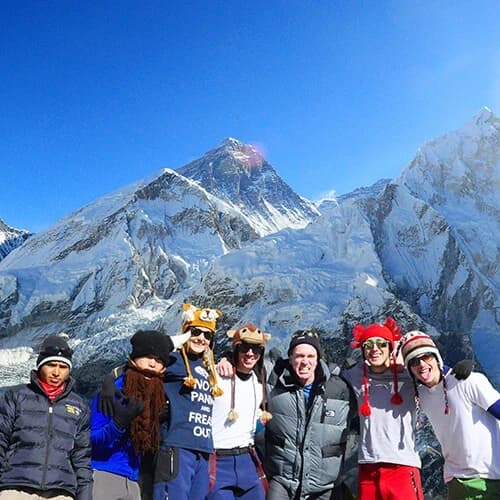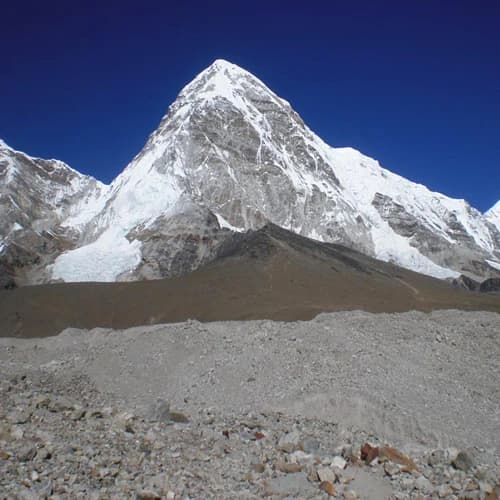Understanding Trekking in The Everest Region
The first step of the EBC trek preparation goes into understanding the Everest Region and collecting as much information as possible about the trek. Every trekking region is different, and even different hikes in the same region vary depending on the altitude range, length, duration, etc. So, do your research even before starting to prepare. Look for information online, read blogs, watch vlogs, talk to friends or family who've done the trek before, and reach out to trekking companies who organize treks in the Everest Region.
We've gathered some crucial information about the Everest Base Camp Hike. Let's look at them quickly, and please don't forget to do your own research.
Trek Location & Landscape
Everest Base Camp is located in the eastern Himalayan foothills of Nepal at a height of 5364 meters above sea level. It falls under the Khumbu region, and you'll be trekking in the protected area of the Sagarmatha National Park most of the time. The trails consist of highs and lows in rough Himalayan terrain, so make sure you carry sturdy hiking boots.
Since it is the base camp of Mt. Everest, it lies in the alpine region filled with rocky mountains covered by snow. However, you'll have to pass by dense sub-tropical forests, Sherpa communities, green hills, and barren pastures to get to EBC. A flight from Kathmandu to Lukla is the only way to enter the Everest region.
Trek Type
The EBC trek is a tea house trek. Hence, you won't have to carry, set up, sleep in tents, and cook your own food. The Everest region has the best food and lodging facilities due to its long history of climbing and trekking. Looking at the towns like Lukla and Namche, you won't believe those are tucked away in the Himalayas. You'll find everything from luxury hotels to cute cafes, bars, and pubs, with international cuisines and drinks to enjoy here.
Trek Length
The total trekking length from Lukla (the trailhead of the trek) to Everest Base Camp is approximately 65 km. Trekking both ways makes it a total of about 130 km. You'll be walking an average of 10 to 15 km every day.
Trek Duration
The Everest Base Camp hike is usually a 14 days journey from the day you arrive in Kathmandu till the day you fly back. Excluding flight days and rest days, you'll be on trail trekking for 9 days (6 days to ascend and 3 days to descend).
Trek's Altitude Range
Lukla, the starting point of the EBC trek, is at a height of 2860 m, and Kala Patthar, the trek's highest point, is at 5545 m. So, you'll be trekking and acclimatizing between 2860 meters and 5545 meters above sea level with 30% to 50% oxygen deficiency. You'll gain a total of 2700 m in a span of 8 days with an average altitude gain of 500 m per day.
Trek's Weather
The Everest region's weather changes according to the season. The spring and autumn are warm and cozy, with more than enough daylight to complete the hike. The nights are cold, but the days are sunny, with a clear sky and little to no rain. So, these are the best seasons to trek to EBC. Winners are too cold and snowy, but the skies are clear in the mornings. The monsoons, on the other hand, have the worst weather, with rains in the lower region and abrupt visibility.
It's important to find out the weather and temperature of the region you're trekking to so that you can mentally prepare yourself for that weather and pack appropriate clothing.
The trek's difficulty depends on all the factors mentioned above. So, your preparation should also depend on those. Make your training plan accordingly. Once you clearly understand what you're signing up for, you can move on to the next phase of trek preparation.
Physical Fitness Training and Mental Preparation
Physical fitness training and mental preparation go hand in hand. Once you start the fitness training, you'll see changes in your body and strength which builds confidence. Along with physical exercise, we also have some mental training for you to develop your mental strength. Let's go through them one by one.
Physical Fitness Training
Your fitness level is one of the determining factors among altitude sickness and natural calamities that decide whether you'd make it to the Everest Base Camp. There have been numerous examples of people not making it to the top due to their poor physique. Don't let your body stop you from your dream trip; train it instead for a unique trekking experience in the Himalayas that you'll remember for a lifetime.
Remember, continuously walking on the rough Himalayan terrain of uphills and downhills need a great level of fitness. If you're already on your fitness journey or an expert hiker, you just need to modify your fitness routine to train your body to prepare for the EBC. If you're a beginner, you must start from scratch and make it all the way up to the Everest Base Camp.
Based on your fitness level, it's best to start training 3 to 6 months before the departure date. Remember to start at a level you're comfortable with to prevent any injury and increase the intensity and duration as you improve. Training your body for this adventure is also a great way to improve your overall health and fitness. You must follow multiple training routines to get your body ready for EBC. We'll discuss each of them below. Please keep reading.
Hiking Practices
The best way to prepare for the trek is to go outdoors and explore. Look for hiking areas around you, hike at the parks, or just walk around. While preparing for the Everest Base Camp, you'll also get to know your city better. Start with shorter lengths and gradually increase the distance. You'd be surprised how your body builds up endurance with each passing hike.
If you live in a mountainous or hilly region, take the path that takes you up and down the hills. Maintain the hiking circumstances as close as the actual EBC trail if possible (steep trails, long day hikes, high altitude, cold temperature, etc.). Make sure to wear your trekking boots and carry some weights in your backpack while training. If you're hiring a porter for your EBC trek, you can limit the weights to 5 kg; else, start with 5, and be sure to carry 10-12 kg by the end of your training period.
Cardiovascular Endurance
Building your cardiovascular endurance is a crucial part of your preparation. Why? A cardiovascular workout routine consists of aerobic exercises that use oxygen to fuel your muscles. So, cardio workouts help your body work with less oxygen. Although trekking involves walking continuously at a slow pace with frequent rests in between (which can't actually be compared to cardio workouts), you'll have less oxygen to work with when you're trekking at high altitudes. Hence, cardiovascular training will train your body to keep going without getting much tired when walking at the 5000+ meters altitude of Everest Base Camp.
Here's a list of cardio or aerobic exercises to incorporate in your training:
- Running
- Jogging
- Cycling
- Swimming
- Zumba
- Jumping Jacks
- Burpees
- Squat Jumps
- High Knees
- Box Jumps
- Running along stairs / Using a step-mill machine
Strength Conditioning
A strong body, especially the legs, makes your Everest Base Camp Hike much more enjoyable. Although strength training isn't as important as cardio, it conditions your body to the stress it has to endure during the hike. Continuous walking for over a week puts pressure on your lower body (legs). Similarly, it also takes a solid upper body (shoulders) to carry a backpack and use trekking poles. So, partake in strength conditioning or resistance training along with your cardio for better preparation. Perform a full-body strength workout 2-3 times a week. You can hit the gym or work out at home with free weights to replicate the hiking conditions of EBC.
Here are some strength or resistance workouts you can practice:
For Lower Body
- Squats
- Step-ups
- Lunges (with weights)
- Side Lunges
- Leg curls (front and reverse)
- Deadlifts
For Upper Body
- Pull-ups
- Push-ups
- Bench presses
- Overhead presses
- Shoulder presses
- Kettle-bell rows
- Back & shoulder fly
Altitude Training
No matter how hard you train your body before the trek, if you're training at low altitudes, you can't actually predict how your body reacts to high altitudes. AMS (Acute Mountain Sickness) may affect anyone, old or young, weak or strong. We'll come to this in a while, but now, if you have access to higher altitude hikes, please go for a couple of them before attempting the EBC. It does not have to be as high as the EBC; just go for any height possible.
Downhill Training
What we usually forget while preparing for the treks is that we have to hike all the way down after reaching our destination. Let's remember that most accidents happen on the way down. Hiking downhill may not be as demanding as hiking uphill, but it still stresses your legs, knees, and shoulders. So, it's best to accustom your body to walking down so that it can learn to put the least amount of pressure on your knees.
The best way for downhill training is to hike down hills. If that's not possible in your area, you can take the stairs while going down. Some exercises like step-downs, squats with elevated heels, single-leg squats, lunges with weight, calf raises, core-focused workouts, stability and balance practices, etc., help you train your body for downhill hiking.
Do's and Dont's During Physical Fitness Training
- Do warm-up and cool-down exercises before and after each training session. It gets your muscles ready for the workout and prevents any possible injury.
- Don't attempt to do everything at once. Take time and gradually increase the intensity and duration of your training to prevent fatigue and injury.
- Do listen to your body. Do a little less if you are weary and a little more if you feel particularly strong.
- Don't worry if you can't give much time for the training. You can utilize your lunch hours for a walk or weekends for other activities. Bring your family together and go for fun weekend hikes.
- Do incorporate plenty of recovery days in your training plan. Your body needs rest to regain its energy and strength.
- Don't train during the last week. Give your body enough rest so you can start fresh while trekking.
- Do wear your hiking boots and backpack as much as you can while training to prepare your body for the trek's actual demands.
Mental Preparation
When you choose this trek, you're not just signing up for the extraordinary natural beauty, rich culture, and delicious local meals. You're also in for accepting and withstanding the challenges that come your way. There will be days when your body gets too tired and wants to give up, but it'll be your mental strength that gives you the courage to keep going. Hence, mental preparation is as vital as physical while preparing for the Everest Base Camp.
Mental strength isn't easy to gain, and there's no straightforward training for it. But with some mindfulness exercises along with yoga and meditation, you can train your mind to respond to challenges gracefully. Most of the mental work is done when you feel confident about yourself. Once you start seeing improvements in your body due to physical training, you'll start gaining confidence. So, mental preparation and physical training go hand in hand.
Here are some techniques to attain a correct mindset that will help you with the EBC hike:
Being Open to Change
We all know how unpredictable the mountains are. When you're in the Himalayas, not everything goes as planned. You might encounter some unfortunate weather circumstances or even health issues that hinder your itinerary or may even lead to trip cancellation. You have to be prepared for the worst. You can't go against nature. Even the Himalayan landscape will be new to you. So, practice the habit of being open to change for an enjoyable trekking experience.
Building Positive Attitude
As we said earlier, there will be times when you feel too exhausted and want to give up. The earlier day's hike might cause soreness in your muscles. On longer hiking days, your body may feel like you can't take any more walking. What helps you during these circumstances is your positive attitude. Try and look at the bright side. Remember how much you've already come along, and just a little push will take you nearer to your goals. So, build a positive attitude in your day-to-day life, and this practice will immensely help you during the hard days.
Practising Gratitude
You need to remember that you're trekking in one of the remotest regions in the entire world. As you go higher, the services available there may not be up to the mark. In peak seasons, you might even have to sleep in the dining hall due to a lack of space. You might not get internet services or even be able to charge your phones. It's hard for you alone to trek these mountains, imagine how difficult it would be for the businesses to sustain depending on porter-carried goods. So, be grateful for what you have. Not everyone gets to stand at the foothill of Mt. Everest. You're one of the fortunate ones.
Cultural Acceptance
The mountain people are extremely friendly and kind. They appreciate politeness and friendliness. At the same time, they're tremendously proud of their culture. Some of their practices might feel strange to you, but it's their way of life, and you're just a guest. You must, therefore, learn to appreciate their culture and act courteously toward them while on the walk. A wide smile and joined hands with "Namaste" or "Tashi Delek" will do the trick. Keep in mind that locals will take good care of you and make your stay pleasant if they like you.
Proper Acclimatization
The third stage of the trek preparation, i.e., acclimatization, begins once you begin the trek. As EBC is a high-altitude trek, there's a high risk of altitude sickness, also known as Acute Mountain Sickness (AMS). Altitudes above 3000 meters present you with the chance of AMS as there's a declination in oxygen content in the air. The air gets thinner and thinner as you trek higher, making breathing more challenging.
Symptoms of altitude sickness include headache, shortness of breath, increased heartbeat, dizziness, difficulty sleeping, nausea, vomiting, loss of appetite, and so on. If you experience any of these symptoms, you should immediately contact your trek guide and take appropriate measures. If the symptoms worsen, you should stop hiking and stay at that place or hike back to a lower altitude and rest until you feel better.
Proper acclimatization, as you reach the 3000 meters mark, helps your body adapt better to the declining oxygen level in the air. Let's explore some of the ways to acclimatize better in high altitudes to complete the trek successfully.
Hike slowly
"Slow and steady wins the race." This statement is a mantra for high-altitude trekking. Some people tend to speed up in order to make it to their destination fast, which is a recipe for disaster. When you're walking fast, your body doesn't get enough time to adjust to declining oxygen in the air. So, take your time and go slowly. Take frequent breaks, appreciate the view, and enjoy every bit instead of taking it as a task to complete. You're on vacation, not a competition.
Take rest days while ascending
Rest days or acclimatization days are super important to trek to Everest Base Camp successfully. Do not skip these acclimatization days at any cost. Most EBC itineraries include two rest days, one in Namche Bazaar and another in Dingboche. Utilize these rest days by exploring the town, hiking nearby, and learning about the local culture and traditions.
Spend the night at a lower elevation
Even if you have hiked much higher elevations than the previous days, make sure to stay the night at a slightly lower height so that you won't have to face any difficulty at night. As you have already been subjected to a higher elevation during the day, your body would be fine at a lower elevation so you can sleep peacefully at night. The daily elevation gain should be around 500 m.
Eat well and stay hydrated
Eating well and drinking as much fluids as you can is another great way to beat altitude sickness. Eat a balanced diet with enough carbs and protein content to get enough energy to sustain lengthy hiking days. Drink 4 - 5 liters of water daily, as you'd lose water from sweating. If drinking plain water is too much for you, drink garlic soup and ginger tea. Refrain from drinking and smoking while hiking as it dehydrates your body. If possible, quit drinking and smoking at least a month prior to the trek.
Additional Tips for EBC Trek Preparation
In addition to the techniques mentioned above, you must keep some other things in mind to prepare yourself better for the EBC trek. These additional tips play a significant role in making or breaking your trip. So, prepare yourself fully with the following tips for a fantastic EBC Trekking experience.
Pick the best season
Although people trek to EBC all year round, spring and autumn are the best times for this trek, with stable weather, a vibrant atmosphere, and clear visibility. The days are warm and sunny, which is pleasant for day hikes, and the nights are cool. This is why spring and autumn are the peak trekking seasons in the Everest region, making for a comfortable trip. Winter being too cold and monsoon/summer being too wet aren't very popular for trekking.
Have some buffer days
Due to bad weather, the flights from Kathmandu to Lukla or back tend to get delayed or even canceled sometimes. The canceled flights take off the next day if the weather permits. Even during the trek, some days may be unfavorable for hiking due to weather circumstances or your health condition. So, it's best to be flexible with your itinerary and keep some extra days before you fly back home so that you don't have to cancel and rebook expensive international flights.
Pack appropriate clothing and gear
You need to pack all appropriate clothing and hiking gear based on which month you're trekking. Pack some warm woolen clothes for nights and light clothes for hiking during the day. Make sure you have sturdy hiking boots that you've worn before to avoid any blisters. Carry a first-aid kit with your regular prescriptions and other medicines, as you won't find any hospitals on the trail. Get some protein bars and chocolate. Take some cash for additional expenses.
Stretch before and after the hike each day
Due to hiking all day, your body becomes stiff and your muscles sore. To stay away from stiffness and sore muscles, make sure to do a quick stretching routine every day before you begin the hike in the morning and after you finish it in the evening.
Insurance with Helicopter Rescue
You require travel insurance in order to trek in the Everest region. Due to the absence of any health service in the remote Himalayas, you might have to be airlifted to Kathmandu in case of weather and health emergencies. So, make sure your insurance covers the helicopter rescue. Otherwise, it is going to be super expensive for you. Insurance also takes care of canceled flights and lost baggage, so go for the insurance with the best policy.
Booking with a Professional Company
You can book your EBC trek in person once you arrive in Kathmandu or online before you even fly to Nepal. No matter how you book, ensure that you're booking your EBC trek with a professional company. If you're booking in person, visit their office, talk to the guides, and only book once you're sure about them. If you're reserving the trip online, visit their websites, look for their reviews on TripAdvisor, talk to them on the phone, and then book the trip.
Outfitter Nepal Treks and Expedition is a trustworthy local trekking company based in Kathmandu. We have been in the industry for over 2 decades, and we know how to turn your dream trek into an awesome reality. We employ highly experienced trekking guides who'd take good care of you in the mountains. The reviews left by our previous clients speak for themselves. Be our guest, and we'll guarantee you the trip of your lifetime!
Important: Some medical conditions like Asthma, Sickle Cell Anemia, Pulmonary Hypertension, Obesity Hyperventilation Syndrome, Carotid Surgery, Congenital Heart Problems, Pregnancy, etc. put the hiker at risk. So, we recommend you consult with your doctor before you begin your preparation.
Despite the difficulties, anyone with good physical fitness and calm mental composure can trek to EBC if they follow proper acclimatization. So don't wait any longer for your dream trek to Everest Base Camp. Start training your body and mind right now! You'll start noticing the progress within a few weeks, and in a few months, you'd be ready to hit the EBC trail.
For any further information regarding the Everest Base Camp Hike or booking procedure, please reach out to us (Email: info@outfitternepal.com, Whatsapp: +977 9851137385, We'd be thrilled to host you. Happy Trekking!
Some Most Popular Treks




